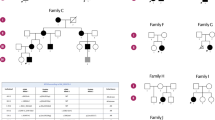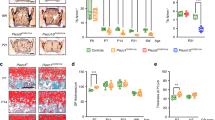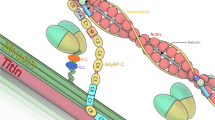Abstract
The genetic work-up of arthrogryposis is challenging due to the diverse clinical and molecular etiologies. We report a-183/12-year-old boy, from a 2nd degree consanguineous family, who presented at 36/12 years with hypotonia, distal laxity, contractures, feeding difficulties at birth. He required surgery for progressive scoliosis at 16 years of age, and walked independently since then with an unstable gait and coordination defects. His latest examination at 18 years of age revealed a proprioceptive defect and loss-of-joint position sense in the upper limbs. Somatosensory evoked potentials supported bilateral involvement of dorsal column-medial lemniscal sensory pathways and nerve conduction studies revealed a mild axonal neuropathy. Muscle biopsy showed myopathic changes with neonatal myosin expression. Mendeliome sequencing led to the discovery of a recessive stop mutation in piezo-type mechanosensitive ion channel component 2 (PIEZO2, NM_022068, c.1384C>T, p.R462*). PIEZO2 is a nonselective cation channel, expressed in sensory endings of proprioceptors innervating muscle spindles and Golgi tendon organs. Dominant PIEZO2 mutations were described in patients with distal arthrogryposis type 5 and Marden–Walker syndrome. Sensory ataxia and proprioception defect with dorsal column involvement together with arthrogryposis, myopathy, scoliosis and progressive respiratory failure may represent a distinct clinical phenotype, and indicate recessive mutations in PIEZO2.
Similar content being viewed by others
Log in or create a free account to read this content
Gain free access to this article, as well as selected content from this journal and more on nature.com
or
References
Hall, J. G. Arthrogryposis multiplex congenita: etiology, genetics, classification, diagnostic approach, and general aspects. J. Pediatr. Orthop. B 6, 159–166 (1997).
DeMyer, W. & Baird, I. Mortality and skeletal malformations from amniocentesis and oligohydramnios in rats: cleft palate, clubfoot, microstomia, and adactyly. Teratology 2, 33–37 (1969).
Swinyard, C. A. Concepts of multiple congenital contractures (arthrogryposis) in man and animals. Teratology 25, 247–258 (1982).
Hall, J. G. Arthrogryposis (multiple congenital contractures): diagnostic approach to etiology, classification, genetics, and general principles. Eur. J. Med. Genet. 57, 464–472 (2014).
Fazeli, W., Karakaya, M., Herkenrath, P., Vierzig, A., Dotsch, J., von Kleist-Retzow, J. C. et al. Mendeliome sequencing enables differential diagnosis and treatment of neonatal lactic acidosis. Mol. Cell. Pediatr. 3, 22 (2016).
Coste, B., Houge, G., Murray, M. F., Stitziel, N., Bandell, M., Giovanni, M. A. et al. Gain-of-function mutations in the mechanically activated ion channel PIEZO2 cause a subtype of distal arthrogryposis. Proc. Natl Acad. Sci. USA 110, 4667–4672 (2013).
McMillin, M. J., Beck, A. E., Chong, J. X., Shively, K. M., Buckingham, K. J., Gildersleeve, H. I. et al. Mutations in PIEZO2 cause Gordon syndrome, Marden-Walker syndrome, and distal arthrogryposis type 5. Am. J. Hum. Genet. 94, 734–744 (2014).
Okubo, M., Fujita, A., Saito, Y., Komaki, H., Ishiyama, A., Takeshita, E. et al. A family of distal arthrogryposis type 5 due to a novel PIEZO2 mutation. Ame. J. Med. Geneti. A 167A, 1100–1106 (2015).
Coste, B., Mathur, J., Schmidt, M., Earley, T. J., Ranade, S., Petrus, M. J. et al. Piezo1 and Piezo2 are essential components of distinct mechanically activated cation channels. Science 330, 55–60 (2010).
Cahalan, S. M., Lukacs, V., Ranade, S. S., Chien, S., Bandell, M. & Patapoutian, A. Piezo1 links mechanical forces to red blood cell volume. eLife 4 (2015).
Ranade, S. S., Syeda, R. & Patapoutian, A. Mechanically activated ion channels. Neuron 87, 1162–1179 (2015).
Retailleau, K., Duprat, F., Arhatte, M., Ranade, S. S., Peyronnet, R., Martins, J. R. et al. Piezo1 in smooth muscle cells is involved in hypertension-dependent arterial remodeling. Cell Rep. 13, 1161–1171 (2015).
Woo, S. H., Lukacs, V., de Nooij, J. C., Zaytseva, D., Criddle, C. R., Francisco, A et al. Piezo2 is the principal mechanotransduction channel for proprioception. Nat. Neurosci. 18, 1756–1762 (2015).
Dubin, A. E., Schmidt, M., Mathur, J., Petrus, M. J., Xiao, B., Coste, B. et al. Inflammatory signals enhance piezo2-mediated mechanosensitive currents. Cell Rep. 2, 511–517 (2012).
Chung, M. K., Park, J., Asgar, J. & Ro, J. Y. Transcriptome analysis of trigeminal ganglia following masseter muscle inflammation in rats. Mol. Pain (e-pub ahead of print 4 October 2016; doi:10.1177/1744806916668526).
Yang, H., Liu, C., Zhou, R. M., Yao, J., Li, X. M., Shen, Y. et al. Piezo2 protein: a novel regulator of tumor angiogenesis and hyperpermeability. Oncotarget 7, 44630–44643 (2016).
Chesler, A. T., Szczot, M., Bharucha-Goebel, D., Ceko, M., Donkervoort, S., Laubacher, C. et al. The role of PIEZO2 in human mechanosensation. N. Engl. J. Med. 375, 1355–1364 (2016).
Coste, B., Xiao, B., Santos, J. S., Syeda, R., Grandl, J., Spencer, K. S. et al. Piezo proteins are pore-forming subunits of mechanically activated channels. Nature 483, 176–181 (2012).
Ge, J., Li, W., Zhao, Q., Li, N., Chen, M., Zhi, P. et al. Architecture of the mammalian mechanosensitive Piezo1 channel. Nature 527, 64–69 (2015).
Mahmud, A. A., Nahid, N. A., Nassif, C., Sayeed, M. S., Ahmed, M. U., Parveen, M. et al. Loss of the proprioception and touch sensation channel PIEZO2 in siblings with a progressive form of contractures. Clin. Genet. (e-pub ahead of print 8 September 2016; doi:10.1111/cge.12850).
Acknowledgements
We acknowledge our patient and his parents. This work was supported by Muscular Dystrophy Association, USA, and Deutsche Forschungsgemeinschaft, Germany grants to Dr SC.
Author information
Authors and Affiliations
Corresponding author
Ethics declarations
Competing interests
The authors declare no conflict of interest.
Additional information
Supplementary Information accompanies the paper on Journal of Human Genetics website
Rights and permissions
About this article
Cite this article
Haliloglu, G., Becker, K., Temucin, C. et al. Recessive PIEZO2 stop mutation causes distal arthrogryposis with distal muscle weakness, scoliosis and proprioception defects. J Hum Genet 62, 497–501 (2017). https://doi.org/10.1038/jhg.2016.153
Received:
Revised:
Accepted:
Published:
Issue date:
DOI: https://doi.org/10.1038/jhg.2016.153
This article is cited by
-
Spinal scoliosis: insights into developmental mechanisms and animal models
Spine Deformity (2025)
-
Muscle spindle function in healthy and diseased muscle
Skeletal Muscle (2021)
-
TrendyGenes, a computational pipeline for the detection of literature trends in academia and drug discovery
Scientific Reports (2021)
-
Innocuous pressure sensation requires A-type afferents but not functional ΡΙΕΖΟ2 channels in humans
Nature Communications (2021)
-
Piezo2 expressed in proprioceptive neurons is essential for skeletal integrity
Nature Communications (2020)



